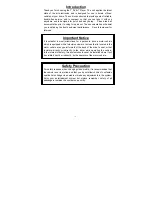
16
TO ADD GASOLINE:
1. Place the generator on a level surface. Make sure the
engine is OFF before adding or checking the fuel.
2. Unscrew the fuel cap (Fig. 6) and set it aside. The fuel
cap may be tight and hard to unscrew.
3. Slowly add unleaded gasoline to the fuel tank. Be careful
not to overfill. Reinstall fuel cap and wipe clean any spilled
gasoline with a dry cloth.
NOTE:
Do not fill the fuel tank to the very top. If you do
so, gasoline will expand and spill during use, even with
the fuel cap in place.
TO CHECK GAS LEVEL
(before every subsequent start):
1. Before starting the generator, check the fuel gauge (Fig.
7) to see if there is sufficient fuel inside the tank:
• E
= Empty
• F
= Full
2. If the tank is empty add gasoline to the gas tank. See
above section, "To Add Gasoline".
STEP 3 - GROUND THE GENERATOR
To reduce the risk of electric shock and to maximize safety,
the generator should be properly grounded.
1. Attach one end of the grounding wire to the grounding
nut (Fig. 7). Tighten the nut to secure the grounding wire.
2. Connect the other end of the grounding wire to a copper,
brass, or steel-grounding rod that is driven into the earth.
Fuel Cap
Fuel Cap
WARNING!
Failure to properly ground the
generator increases your risk of electric shock.
NOTE:
Grounding wire and grounding rods are not
included with the generator. A generally acceptable
grounding wire is a
No. 12 AWG (American Wire
Gauge) stranded copper wire
. Grounding codes
can vary by location. Contact a local electrician to
check the area codes.
GENERATOR PREPARATION
Fig. 6
Fuel Cap
Fig. 7
Grounding Nut
















































